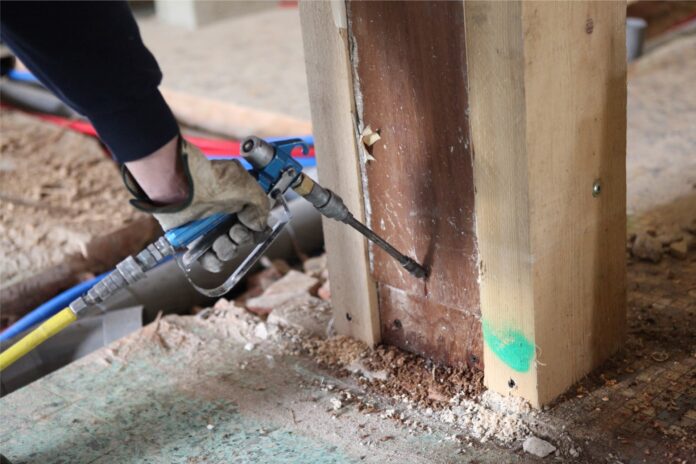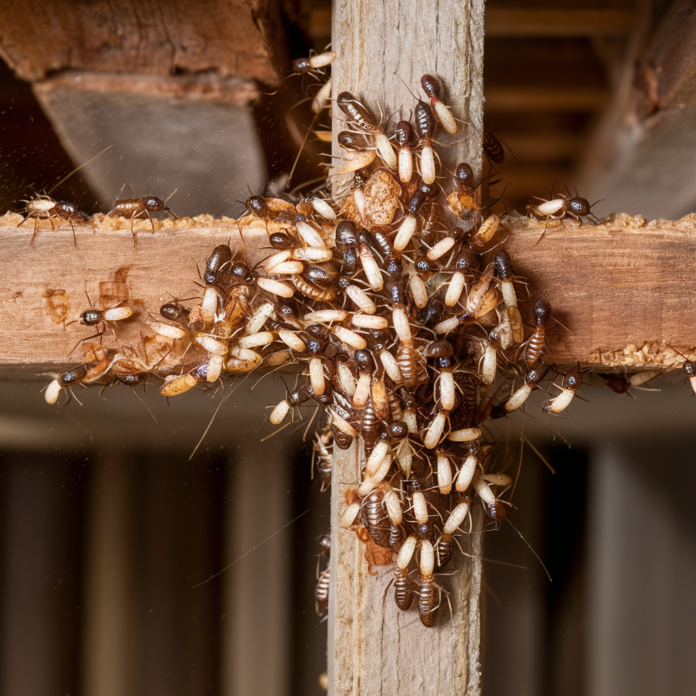Termites pose a significant threat to homes, causing extensive damage if left untreated. Effective termite treatments are crucial to protect properties from these persistent pests.
Today, we aim to answer the question: Are expensive termite treatments worth it for persistent problems?
Knowing Termite Risks
Termites can cause severe structural damage to homes, often going unnoticed until significant harm has been done. The potential for damage is immense, as termites feed on wood, paper, and other cellulose-based materials.
Common signs of termite infestation include the presence of mud tubes along walls, hollow-sounding wood, and discarded wings from swarmers. These indicators signal active termite colonies within or near the home.
There are different types of termites, each with unique characteristics. Subterranean termites, which build extensive underground colonies, are the most common and destructive type in the United States.
They create mud tubes to travel between their nest and food sources. Drywood termites, on the other hand, do not require contact with soil and infest dry wood.
They are often found in coastal and warm regions. Dampwood termites prefer moist wood and are usually found in areas with high humidity.
Understanding the types of termites and their behavior is crucial in selecting the appropriate treatment method.
For example, subterranean termites might be best managed with baiting systems or chemical treatments, while drywood termites may require direct wood treatment or termite fumigation.
Types of Termite Treatments

There are several methods available for termite treatment, each with its own set of advantages and limitations.
Regular inspections and spraying are the most basic forms of termite control. Inspections help identify infestations early, while spraying insecticides can provide a temporary barrier against termites.
Baiting systems involve placing bait stations around the property to attract termites. These stations contain a slow-acting poison that the termites carry back to their colony, eventually eradicating it.
Baiting is effective for subterranean termites but requires regular monitoring and maintenance.
Chemical treatments and termiticides are commonly used for both prevention and active infestations. These treatments create a barrier in the soil or on wood surfaces to kill or repel termites.
Liquid termiticides can provide long-lasting protection, but proper application is critical to their effectiveness.
Heat treatments and other advanced methods, such as termite fumigation, are used for severe infestations. Heat treatments involve raising the temperature in the affected area to a level that is lethal to termites.
Termite fumigation involves sealing the structure and introducing a gas that permeates all areas, killing termites throughout the building. These methods are highly effective but are also among the most expensive options.
Choosing the right treatment depends on the type of termite, the severity of the infestation, and the specific conditions of the property. A combination of methods may often be necessary for comprehensive termite control.
Costs of Termite Treatments

The cost of termite treatments can vary widely, ranging from as low as $300 to upwards of $5,000, depending on several factors.
The severity of the infestation is a primary determinant; more extensive damage and larger colonies require more intensive and costly treatments. The type of termite also influences costs; subterranean termites might need different treatments compared to drywood termites, each with its own cost implications.
The size and structure of the property play a significant role in the overall cost. Larger homes or buildings with complex layouts may require more extensive treatment, increasing labor and material costs. The geographical location of the property can impact pricing, as termite prevalence and treatment costs vary by region.
Expensive treatments, such as termite fumigation or heat treatments, tend to be at the higher end of the cost spectrum. These methods provide thorough eradication and long-term protection but require specialized equipment and expertise, contributing to their higher cost.
On the other hand, basic methods like regular inspections and localized spraying are more affordable but may not be sufficient for severe or persistent infestations.
Understanding the factors that influence treatment costs helps homeowners budget appropriately and choose the most effective solution for their termite problems.
Benefits of Expensive Termite Treatments
Investing in expensive termite treatments offers several significant benefits. These treatments provide comprehensive coverage and thorough eradication of termite colonies, ensuring that all pests are eliminated. This level of effectiveness is crucial for persistent or severe infestations where standard treatments may fall short.
Long-term protection is another key advantage. Expensive treatments often include preventive measures that safeguard the property from future infestations. This proactive approach helps maintain the integrity of the structure and reduces the likelihood of recurring problems.
Financial security through warranties and damage coverage is a notable benefit of high-end treatments. Many professional pest control companies offer warranties that cover retreatment or damage repair for a specified period. For example, some contracts might include a $1,000,000 damage warranty, providing peace of mind and financial protection against termite-related expenses.
Maintaining property value is an important consideration for homeowners. Termite damage can significantly devalue a property, making it difficult to sell. Expensive treatments not only prevent damage but also demonstrate to potential buyers that the property has been well-maintained and protected against pests.
Overall, the benefits of investing in high-quality termite treatments far outweigh the costs, especially for properties with a history of persistent termite problems.
Professional vs. DIY Control

Choosing between professional pest control services and DIY treatments involves weighing the pros and cons of each approach.
Professional services offer several advantages, including expertise, specialized equipment, and access to effective treatment methods that are not available to the general public.
Pest control professionals are trained to identify the specific type of termite and the extent of the infestation, ensuring that the most appropriate treatment is applied.
Professional treatments, such as termite fumigation or heat treatments, provide comprehensive eradication and long-term protection.
These methods require specialized knowledge and equipment, making them impractical for most homeowners to attempt on their own. Regular inspections by professionals can also catch early signs of infestations, preventing severe damage.
DIY treatments, while more affordable, come with significant limitations. Over-the-counter products may not be as effective as professional-grade treatments, and improper application can lead to incomplete eradication or even worsening of the infestation.
DIY methods often require frequent reapplication and monitoring, which can be time-consuming and less reliable.
The importance of professional expertise and regular inspections cannot be overstated. Professional pest control services ensure that treatments are applied correctly and efficiently, providing peace of mind and long-term protection for the property.
The Bottom Line
Expensive termite treatments offer thorough eradication, long-term protection, and peace of mind, making them worth the investment. Professional pest control services and comprehensive warranties ensure property protection and value maintenance. For persistent termite problems, investing in professional control is highly recommended.










